
Hi all—Dan here. Today, we have a guest article from Alice Albrecht. Alice is one of the smartest and most experienced under-the-radar builders in AI. She did a PhD in cognitive neuroscience at Yale and then spent 10 years in AI before becoming a founder. Today, she runs re:collect, a startup building an AI-powered thought partner.
As part of her work at re:collect, Alice builds software tools to enhance human creativity. She has an extensive knowledge of the research literature on what creativity is and how humans can do it better, and that's exactly what she writes about for us in this article. It's a detailed and actionable guide to the science of creativity and how to unlock it. I hope you enjoy it as much as I did.
Creativity is our greatest human asset. Beyond the personal joy of creative expression, creative thinking and problem-solving are key drivers of economic growth. Even though plenty of people may not think of themselves as “creatives,” everyone has the ability to think creatively. In that sense, it should be one of the great equalizers, especially as advances in AI and cheaper compute lower the bar for getting from a creative idea to a final output.
Even with the best tools available to turn our creative ideas into something more tangible, though, we still need to provide the initial seed of an idea and be able to judge whether we’re heading in the right direction. We’re still the creative directors of our own minds.
Given this innate capability, how can we improve our creative thinking? As a scientist and a builder, I’ve taken the approach of understanding “the system” and then looking at ways we can augment it. Understanding your own cognition makes it easier to change it.
The science of creativity
Creativity is the ability to produce an artifact or an idea that is both novel and useful given a particular social context (some definitions also include valuable as a necessary requirement). Novelty is an interesting concept if we take the position of, say, a child. In creativity research, it can mean that an idea has sprung from a connection that has never been made or is new to an individual but may be otherwise widely known.
Researchers generally believe that creativity is a two-part process. The first is to generate candidate ideas and make novel connections between them, and the second is to narrow down to the most useful one. The generative step in this process is divergent thinking. It’s the ability to recall, associate, and combine a diverse set of information in novel ways to generate creative ideas. Convergent thinking takes into account goals and constraints to ensure that a given idea is useful. This part of the process typically follows divergent thinking and acts as a way to narrow in on a specific idea.
If you've been part of a "brainstorming" exercise, you've participated in this type of thinking. You may also have seen these concepts reframed as “flaring and focusing” or “explore vs. exploit.”
As our minds begin this dance between divergent and convergent thinking, we first need to have learned some information about how the world works and have some ideas to pull from. We can call our pile of ideas and experience knowledge. This makes memory a critical component of creativity. Memory is a complicated topic, but at a high level, as information related to language—or semantic information—and information related to your senses—or perceptual information—comes into our minds, it is encoded in episodes, or periods of time.
As a memory moves from short-term to long-term storage, what’s represented in that memory is associated with existing memories (aka “schemas”), and your overall understanding of the world shifts slightly. If information is related to what you already know, attaching it to an existing part of your schema helps you understand that information more quickly because you’ve already seen something like it before. For instance, after you read this article, what you know about creativity will have changed. The way memories are associated makes it possible to connect your ideas later. In fact, recent evidence shows that semantic memory structure—how we relate language-based concepts—is one of the biggest predictors of creativity.
While we can study the output of our minds' creative processes by measuring how well people do on different tests of creativity, understanding how our brains give rise to the creative experience helps us understand the process more deeply and fills in a critical component that is thus far missing—attention.
Using neuroimaging techniques, scientists can peek into the black box of our brains and study what happens when someone is generating new ideas. For a moment, let’s assume we are such scientists. If we were to put our research participant (let’s call her Delilah) inside an fMRI scanner and ask her to come up with as many creative uses for a shoe while riding in a boat as she could in one minute, we would observe a volley of activity between specific brain networks.
When Delilah is coming up with all of these different uses (i.e., divergent thinking), a network of brain regions called the "default network" is activated. In brain imaging studies, this network shows the highest activation during spontaneous, self-generated thought—including mind wandering, which is specifically not related to a task. Delilah’s task doesn’t necessarily call for self-generated thought, given we’ve asked her to come up with these uses, but perhaps a stray thought about how hungry she is occurs to her, and now she’s thought of a way to use the shoe to catch fish.
Governing this process is a "control network" that allows us to think flexibly, inhibit outside distractions, and pull from our memory. The control network would help Delilah rule out using the shoe to walk down 5th Avenue, but by also engaging her attention, it could help keep the noise of the fMRI machine from distracting her. You can think of this network as supporting our convergent thinking, like a biological example of the adage, “Constraints breed creativity.”
Switching between the default and control networks is thought to be governed by a "salience network," which helps us to engage each one effectively. Higher creative thinking scores are correlated with greater coupling between these networks. If Delilah comes up with a long and useful list of uses for that shoe, we should observe that she has a more integrated semantic memory structure that represents her knowledge and more dense connections between her default, control, and salience networks. Huzzah! Good work, Delilah.
Now that we have a high-level understanding of the components and the system underpinning creative thinking, we can start to unpack how we might affect our own creative systems for the better.
Build a good “memory bank” full of materials for creation
Memories are the materials needed for creative thinking. Consuming other people's ideas in conversation by reading or listening to them (like you're doing now!) stimulates creativity and deepens existing associations. To widen our divergent thinking funnel, we could try and seek out new ideas that are maximally different from our own, but this typically won’t work. It’s actually better to make incremental steps outside your own filter bubble because new information must overlap somewhat with what you already know to be effectively associated and assimilated. Read voraciously and engage deeply with a wide variety of content to build a richer memory bank for you to tap.
Interact with your materials
Our minds are efficient in the sense that if something isn’t used, it’s not worth expending the resources to keep it readily available. If you read a lot but never revisit or use that information later, some of it may get into your memory, but the connections between the ideas in what you’ve just read and your existing knowledge will likely be weak and fade over time. Taking notes, making highlights, and revisiting that material when it’s related to what you’re currently thinking about is a good way to maintain and strengthen connections. I think of consuming your own writing later as akin to a conversation with yourself through time that re-activates and situates that information in a new world where you've had more experience.
Another good way to interact with your materials is to use them actively. As I illustrated in Delilah’s divergent thinking task, quickly making connections is one of the hallmarks of a highly creative person. These connections can happen spontaneously, often during a period of mind wandering, when our attention is less focused, or during an engaging conversation, when we’re focused but someone else’s ideas are helping spark our own that we can share.
A great way to revisit your materials with intention is by connecting new ideas (perhaps as you’re reading) to existing ones. If the connections don’t suddenly and easily emerge, however, there are a plethora of tools and methods, like Zettlekasten, people employ to intentionally build connections, hoping for creative ideas to bubble up over time. Unfortunately, many of the software tools people use to record and make these connections, like Roam and Obsidian, fail in predictable ways. We can overcome some of these shortcomings using machine learning techniques that mimic the system I’ve laid out above.
While you should certainly set up some sort of creative practice, you can’t force it too much. Connecting ideas on a schedule cannot replicate the serendipity that occurs as our ideas collide with our everyday mundane-seeming experiences, and often creative ideas will only spark after some period of creative incubation.
Mind your mood
Our mental state has a large influence on our creativity. The complete picture is nuanced, but the best state for doing creative thought work depends on the type of work, your attentional state, your mood, and how engaged you can be. In terms of your mood, it’s helpful to be in a positive affective mental state—e.g., happy and not anxious. This doesn’t mean that if you’re feeling a bit down, you won’t have any creative thoughts, but it does mean that you should be investing in your emotional well-being.
Attention is the key
In a productivity-obsessed culture, it’s easy to think that if we just buckle down and focus, we can churn out more creative thought work. Counterintuitively, the more we try and force ourselves to focus, the narrower our thinking may become. Mind wandering is what allows us to explore, retrieve, and experiment with connecting our memories in different ways. So give yourself a break the next time you feel like you're "spacing out."
Far from being too unfocused, with modern technology, we’ve fallen prey to an attention economy that keeps us hyper-focused and often stuck in the memory collection part of the creative thinking process—forgoing the necessary mind wandering. It’s a delicate balance between staying focused on your creative thought work by letting your control network do its job and not missing out on a potentially useful novel conversation happening behind you in the coffee shop.
Finally, all the understanding in the world of how your beautiful mind produces creative thought won’t get you any closer to doing creative work. You simply need to do it often, with intention, but not too much. As my childhood hero, Miss Frizzle, would say, “Take chances, make mistakes, and get messy.”
Alice Albrecht is the founder and CEO of re:collect, a startup building an AI-powered thought partner. She has more than 10 years of experience leading and advising teams building AI/ML-powered products. She holds a Ph.D. in cognitive neuroscience from Yale University.
Ideas and Apps to
Thrive in the AI Age
The essential toolkit for those shaping the future
"This might be the best value you
can get from an AI subscription."
- Jay S.
Join 100,000+ leaders, builders, and innovators

Email address
Already have an account? Sign in
What is included in a subscription?
Daily insights from AI pioneers + early access to powerful AI tools












Comments
Don't have an account? Sign up!